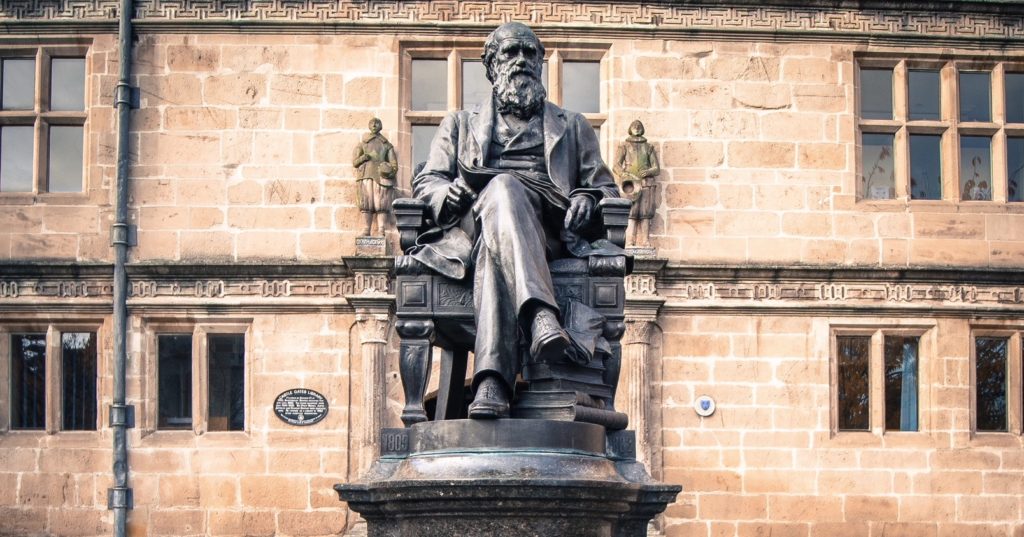 Evolution
Evolution
 Intelligent Design
Intelligent Design
Does the World Need Another Book About Darwin?

Editor’s note: We are delighted to present an excerpt from the new book by Dr. Shedinger, Darwin’s Bluff: The Mystery of the Book Darwin Never Finished. This article is adapted from the Introduction.
What can anyone say that has not already been said about this seminal figure, Charles Darwin, considering the wealth of literature written about him? To the question posed in the headline above, the simple answer is yes, we do need another book about Darwin, for there are aspects of his life and work that have surprisingly continued to evade the attention of his many biographers and interpreters.
The very human Charles Darwin has grown into a mythological figure — the paradigmatic example of a true scientist — without whom nothing in biology would make sense, in the words of Theodosius Dobzhansky. Unfortunately, this mythological figure would be scarcely recognizable to Darwin’s own contemporaries.
Happily for the present enterprise, the flesh-and-blood Charles Darwin is considerably more interesting than the two-dimensional Darwin of the hagiographies.
The state of his scientific legacy is also more intriguing than those same hagiographies would allow — intriguing because it is embattled in ways confessed to in some of the peer-reviewed literature and at high-level scientific conferences but rarely acknowledged beyond these specialized contexts.
Modern scientific advances in fields like molecular biology, genomics, epigenetics, paleontology, developmental biology, and more are raising significant questions about the power of the Darwinian mechanism of variation and natural selection to account for the evolutionary history of life on Earth. Some are calling for an extended evolutionary synthesis while others believe the entire Darwinian edifice needs to be overhauled. It is no longer clear that Darwin can be said to have answered the question of the origin of species. There is thus no reason to begin an investigation into his life and work with the assumption that he did.
Abstract Art
One effect of Darwinian mythology has been to downplay the 19th-century Englishman’s own characterization of The Origin of Species as a mere abstract of his species theory, a summary lacking much of the facts, evidence, and authorities he promised would follow in a later work. The Origin is usually treated as Darwin’s magnum opus, a characterization in keeping with Darwinian mythology but out of step with Darwin’s own view of his work. In truth, The Origin of Species was an abstract of a much larger book on species that Darwin was working on (and that was three-quarters complete) before events forced him to put the larger book aside and instead publish a mere abstract of it.
Once the Origin was in circulation, Darwin’s many correspondents anticipated that he would quickly follow up with the publication of his big book on species so they could better evaluate the argument for natural selection made in the Origin. Indeed, Darwin himself created this expectation both in the Origin and in his correspondence. Even early reviewers of the Origin noted the lack of empirical evidence for natural selection but gave Darwin the benefit of the doubt since the Origin was a mere abstract and therefore could not be expected to provide all the evidence. Given the anticipation among Darwin’s readers for the big book on species, anticipation that Darwin himself repeatedly stoked, why did he never publish the big book? This question is rarely asked.
A rough, handwritten manuscript of Darwin’s big book, titled Natural Selection, survived among his papers and was published by Cambridge University Press in 1975.1 Yet despite the easy access scholars now have to this work (I bought a copy on Amazon), there has been little detailed engagement with its contents or comparison of this work with its abstracted form in the Origin. Such a comparison proves enlightening, for it serves to highlight the secondary nature of the Origin as a hastily written abstract rather than a finely honed scientific treatise, thus challenging the iconic status of the Origin as the foundational text of the modern biological sciences. This, of course, may be precisely why the big book gets overlooked.
Missing Goods
Another reason the big book has been largely ignored, I hope to show, is that it does not deliver the promised goods. This, I will also argue, is the best explanation for why Darwin never brought the book to print. It wasn’t, as one might suppose, that he had made little headway on it and simply lacked the time or energy to produce it. Abstracts are usually distillations of longer works already in existence. So, if the Origin, as Darwin constantly repeats, is only an abstract, it would suggest the big book on species already existed in some substantial form prior to 1859. And in fact, this was the case. The manuscript contained nine chapters and was close to 300,000 words in length. It would likely have been around 400,000 words complete. Given that this book was nearly three-quarters complete, why did Darwin never publish it? And why did he instead turn to the study of orchids as a follow-up to the Origin? Because, as will become clear, he came to see that it did not answer some key criticisms that the Origin had elicited. So, he abandoned the project, even as he allowed anticipation of its publication to persist for many years.
To be sure, Darwin’s orchid book, which he called “a flank movement on the enemy,”2 did attempt to provide some of the evidence for natural selection missing from the Origin (and, as it turns out, missing from the big book as well). He tried to outflank his opponents by putting before them an entirely new work on the numerous contrivances (Darwin’s word) found among orchid flowers to ensure their cross-fertilization by insects. Surely this would impress his readers with the power of natural selection to evolve all these exquisite contrivances.
But Darwin’s strategy failed. Reviewers of his orchid book read it as providing evidence for natural theology, not natural selection. And surprisingly, even Darwin himself in one place likened his orchid book to the Bridgewater Treatises, a series of writings designed to extol the power of God manifest in nature! Could anything be more ironic than that Charles Darwin, the poster child for the triumph of scientific naturalism in biology, actually advanced the cause of natural theology in his day? This is an aspect of his life and work that has been entirely erased by the prevailing mythological Darwinian narrative.
For all these reasons, a more nuanced assessment of Darwin’s evolutionary writings is warranted.
An Enigmatic Victorian
In my engagement with Darwin, I will give pride of place to his voluminous correspondence as the evidentiary basis of this more critical portrait of a truly enigmatic Victorian figure. The argument that lies ahead cites more than 250 letters written by and to Darwin up to the year 1863, some never cited in Darwinian biographies. These letters represent Darwin’s engagement with more than seventy friends, family members, and scientific correspondents. I have elected to adorn the book with many direct quotations from these letters, since I think it is crucial for readers to hear Darwin’s own voice on the page as much as possible to truly encounter the thought patterns and rhetorical style of this fascinating individual.
Many of Darwin’s biographers take the reverse approach — providing their own paraphrases of Darwin’s words — which has the effect of subordinating Darwin to the mythological figure the biography exists to perpetuate. I have also elected, for authenticity’s sake, to retain Darwin’s spelling and punctuation rather than correct them to modern standards. We need to let Darwin speak for himself. It turns out that Darwin, given the opportunity, is quite capable of dismantling his own mythology.
Notes
- R. C. Stauffer, ed., Charles Darwin’s Natural Selection: Being the Second Part of His Big Species Book Written from 1856 to 1858 (Cambridge, UK: Cambridge University Press, 1975). The first two chapters dealing with variation under domestication are missing from the manuscript because Darwin expanded them into his 1868 publication Variation of Animals and Plants under Domestication.
- In a letter to Asa Gray, July 23–24, 1862. See further discussion in Chapter 7.


